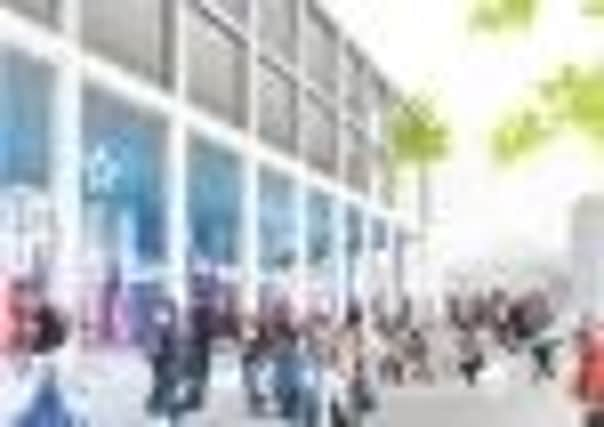Plan to boost Edinburgh’s reputation as arts hub


Four sites have been identified in a council blueprint as cultural “clusters” which will kick-start economic activity as well as provide a focus for the city’s globally famous arts festivals.
Two vacant gap sites and two other traffic-dominated locations which the council wants to transform have been put forward as priorities in the blueprint, with a medium-sized music venue identified as the most urgent requirement.
Advertisement
Hide AdAdvertisement
Hide AdA new home for the Filmhouse Cinema, a permanent base for the Scottish Chamber Orchestra (SCO) and a relocation of the Traverse Theatre to a bigger site are also among the ideas under scrutiny.
A key element is that each site should also become “affordable” new bases for arts organisations and creative companies, but will also be targeted at hotel operators to ensure they are financially viable.
The blueprint has emerged as Jonathan Mills, director of the Edinburgh International Festival, called on the city to commission a masterplan to improve its venue infrastructure. The council envisages cultural projects as catalysts for action to tackle long-standing “problem sites and under-performing parts of the city”. The transformation of all four sites is said to be a “realistic proposition” over the next ten to 15 years. No funding has been set aside by the council to encourage development to get underway, but speculative designs for each site have been produced.
The new blueprint says Edinburgh should emulate Glasgow’s success in turning underused land into new cultural hubs which have reinvigorated the arts scene in the city. It cites the example of the canalside Speirs Lock area, which is now home to Scottish Opera, the National Theatre of Scotland and the Royal Conservatoire of Scotland.
“We could learn from Glasgow’s experience,” the report says. “Even in the boom years, there was a plentiful supply of low-cost, post-industrial land and premises which has proved very attractive to the cultural sector.
“The area known as Speirs Locks, for example, close to the canal on the northern edge of the city centre is a useful case study. Proposals for mixed-use regeneration foundered when the property market stalled in 2008-09, but the area has emerged as one of Scotland’s most dynamic centres of cultural production.”
The blueprint has been published following a summit of venue managers, arts administrators and senior council officials in December.
Among the bodies represented were the Traverse, the Scottish Chamber Orchestra, the Filmhouse, the Edinburgh International Festival, National Museums Scotland, the Queen’s Hall and the Festival Theatre.
Advertisement
Hide AdAdvertisement
Hide AdSue Bruce, the council’s chief executive, has given the initial green light to the ideas behind the blueprint, saying: “We need to ensure the cultural landscape reflects Edinburgh’s place as a cultural centre.”
The biggest site earmarked would involve the demolition of existing buildings between Castle Terrace, Lady Lawson Street, King’s Stables Road and the West Port.
Images produced for the council show how a new multi-purpose 1,800-seater venue could be built on the site and be suitable for both the SCO and the Filmhouse. The existing Castle Street car park would be overhauled to make it suitable to house temporary arts venues overlooking Edinburgh Castle.
An alternative site for a new Filmhouse has also been suggested on part of the former Scottish and Newcastle brewery in Fountainbridge, dubbed “Fountain Quay”, where the Union canal approaches the city centre.
The council also wants to join forces with Edinburgh University to transform the Potterrow area, which sits behind the revamped National Museum of Scotland and the Festival Theatre, but is currently dominated by a busy road.
The fourth site would see the roundabout at Picardy Place, beside the Omni leisure centre, become home to a major new development, on the site of what used to be tenement flats.
The area, opposite St Mary’s RC Cathedral, will be where the first phase of the city’s tram network runs to and from. It was previously earmarked for a hotel as part of the transformation of the St James Centre, which has been shelved indefinitely due to the economic downturn.
The blueprint states: “The council needs to be willing to use its planning powers and manage its estate to protect the places where creative and cultural entrepreneurs work; the manufacturing industry has in large measure been priced out of the city, but we can’t allow that to happen to the cultural sector.”
Advertisement
Hide AdAdvertisement
Hide AdRichard Lewis, the council’s culture leader, said: “These ideas are designed to stimulate and encourage debate. They serve to illustrate that there are various sites across the city with the potential to be imaginatively developed.”
Mills said: “I would be advocating the development of a cultural infrastructure urban masterplan, which looks at the immediate needs, as well as the medium term and longer term.
“You don’t have to do it all at once, but you have a kind of map to tell you where the city is going and when you need to start to make some proper provisions and decisions. Long-term, careful, bipartisan planning is what is needed.”
Twitter: @brianjaffa